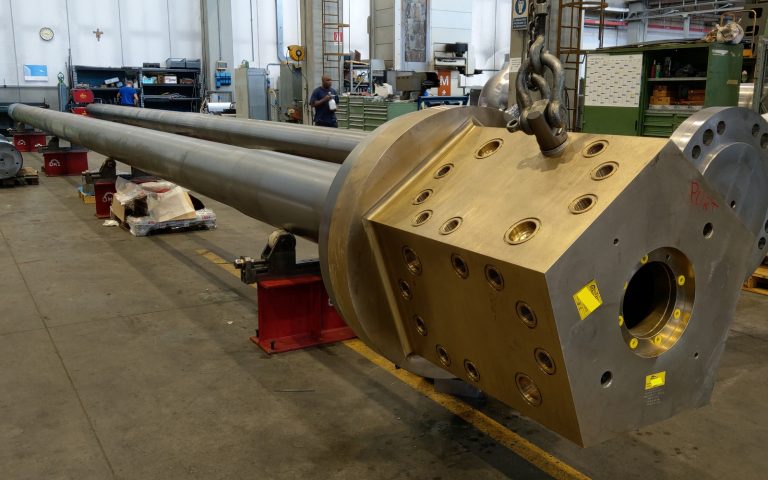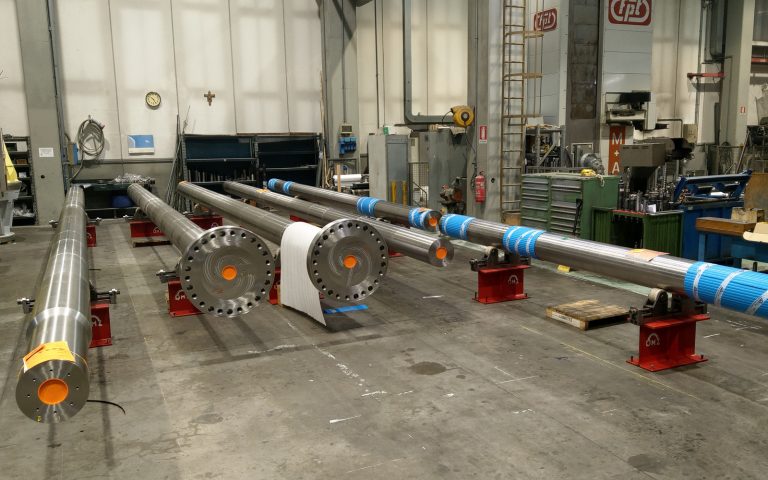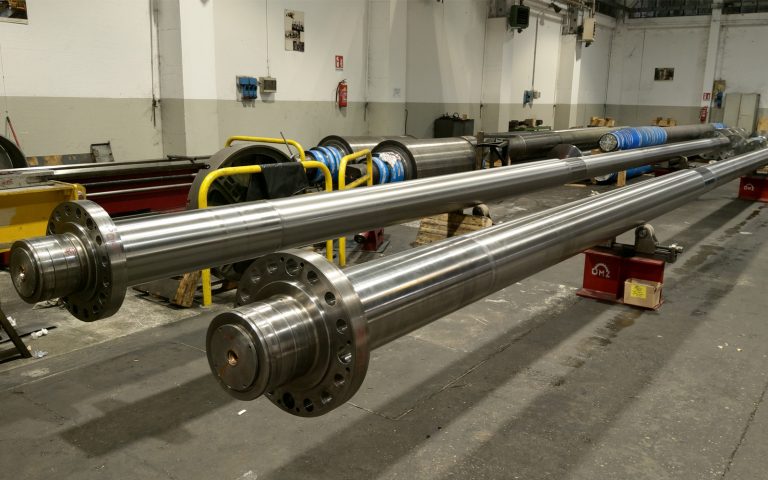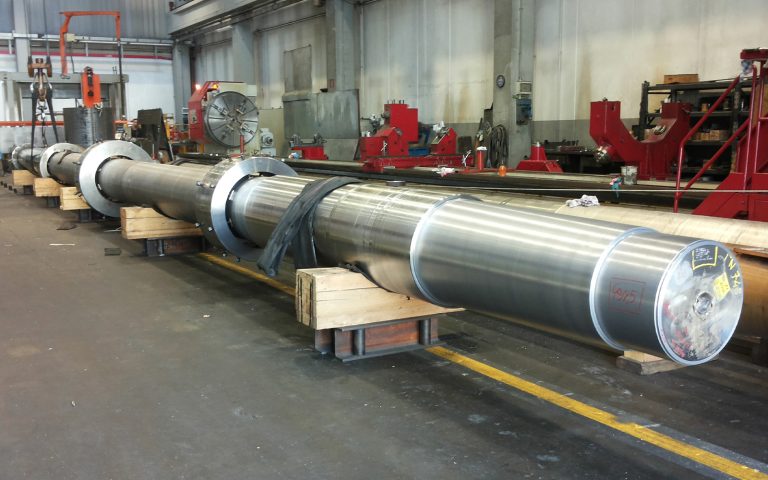Shaft Line Propulsion vs Podded Propulsion Systems
The evolution of marine propulsion systems has significantly influenced the design, efficiency, and operational capabilities of modern vessels.
This paper presents a comprehensive analysis of two predominant propulsion mechanisms: the traditional shaft line system and podded propulsion systems. By examining their design principles, performance metrics, and operational outcomes, this study elucidates the factors that determine the preference for one system over the other across various maritime applications. Scientific data, technical literature, and relevant formulas are integrated to provide a clear understanding accessible to readers without a specialized background in naval architecture.
linea-assi_albero-portaelica
linea-assi_alberi-intermedi
Introduction
Marine propulsion systems are fundamental to the movement and maneuverability of vessels, directly impacting efficiency, speed, and environmental performance. Historically, the conventional shaft line propulsion system has dominated maritime operations. In recent decades, however, technological advancements have introduced podded propulsion systems—a category that includes solutions such as ABB’s Azipod®, Rolls-Royce’s Mermaid, and GE’s Seajet pods. While both systems serve the primary function of converting engine power into thrust, they do so using different design philosophies. This paper compares these systems in terms of mechanical design, performance characteristics, and operational flexibility, and it discusses the circumstances under which each technology is preferred.
Traditional Shaft Line Propulsion System
The traditional shaft line system relies on an internal combustion engine or gas turbine housed within the ship’s hull. This engine delivers mechanical power to a propeller through a connecting shaft. The fundamental operating principle can be expressed by the relation , where represents power, the torque, and the angular velocity of the propeller shaft. A fixed propeller, combined with a rudder placed aft, provides both propulsion and directional control. The simplicity of this design translates into robust performance and ease of maintenance, which are key advantages. However, limitations exist. The fixed orientation of the propeller restricts rapid directional changes, and energy losses occur due to friction along the mechanical transmission. Furthermore, the internal placement of the engine and related components occupies valuable space that could be otherwise allocated for cargo or passenger amenities.
Efficiency in shaft line systems is closely tied to the hydrodynamic interaction between the propeller and the hull. For example, the efficiency can be estimated as the ratio of the useful power output to the power input.
Misalignment or suboptimal positioning may result in increased drag and reduced efficiency.
linea-assi_albero-portaelica
linea-assi_albero-astuccio
Podded Propulsion Systems
Podded propulsion systems represent a significant departure from the conventional shaft line. In these systems, the propulsion unit—housing an electric drive motor—is contained within a pod mounted externally to the ship’s hull. The pod can rotate 360 degrees, thus providing enhanced maneuverability. Notably, among the various podded systems available, ABB’s Azipod® is perhaps the most renowned, having been successfully implemented on vessels such as the Finnish icebreakers MS Fennica and MS Nordica in the mid-1990s. The Rolls-Royce Mermaid system also merits attention, especially for its application in high-end cruise ships like the RMS Queen Mary 2. Early adopters of these technologies experienced initial challenges—such as issues with thrust bearing durability in the Azipod® systems—but subsequent design improvements have addressed many of these concerns.
The operational benefits of pods are considerable. The ability to vector thrust in any direction simplifies maneuvers in confined waters. From a mathematical perspective, the efficiency of podded propulsion can be analyzed by considering the reduced transmission losses. Since the pod eliminates the long mechanical shaft, frictional losses (typically proportional to the surface area and relative motion of the shaft components) are minimized. Moreover, with the pod’s propeller operating in a relatively undisturbed flow, the incidence of cavitation is lower, further enhancing overall efficiency.
In practice, the improved efficiency of podded propulsion is quantified by lower specific fuel consumption (sfoc) values. For instance, research has demonstrated that vessels with podded systems can achieve up to a 20% reduction in fuel consumption compared to similar vessels with traditional shaft lines. This fuel saving is crucial not only from an economic perspective but also for reducing the environmental footprint of marine operations. This conclusion comes from a range of studies and industry reports that have compared similar vessels equipped with traditional shaft lines to those using podded systems. This research conducted by ABB (reported in their technical literature) has shown that the direct drive mechanism in podded propulsion, which minimizes energy losses associated with long mechanical shafts, can lead to efficiency gains on the order of 20%, also considering the savings generated by the optimized hydrodynamic design of pods.
compact-azipod-propulsion
This improvement is attributed not only to reduced friction losses but also to enhanced operational flexibility. For instance, the ability to continuously adjust the thrust vector in podded systems allows the propeller to operate in a more optimal hydrodynamic environment. In conventional shaft line systems, the propeller often works in a disturbed wake field, which can increase cavitation and reduce overall efficiency. The performance advantage is also analyzed through mathematical models where the effective thrust and fuel consumption can be linked by the relation between power, thrust, and efficiency, where improved due to reduced losses translates directly into fuel savings.
In conclusion, the 20% fuel savings figure is supported by both empirical data from operational vessels and theoretical analysis, providing a compelling case for the adoption of podded propulsion in applications where efficiency and maneuverability are paramount. This figure however heavily depends on the ship design and even more on the typology of ship considered and when applied to a bulk carrier or a cruise ship it can vary by a lot.
Comparative Analysis
The differences between the two propulsion systems are stark when viewed through the lens of operational flexibility, fuel efficiency, and space utilization. Traditional shaft line systems offer proven reliability and a straightforward design that many shipping companies continue to favor for bulk carriers, tankers, and container ships. Their simplicity means that maintenance procedures are well established, and spare parts are widely available. However, the fixed nature of the propeller and rudder configuration limits their maneuverability, particularly in tight port conditions.
In contrast, podded propulsion systems deliver a high degree of maneuverability thanks to the 360-degree rotation capability of the pods. This feature is especially beneficial in ports with restricted waterway access or where docking requires precise control. The enhanced maneuverability can be further understood by considering the turning radius of a vessel. For a traditional shaft line vessel, the turning radius is largely dependent on the rudder angle and the hydrodynamic flow around the hull. In contrast, a vessel with podded propulsion can generate lateral thrust directly, significantly reducing the turning radius and allowing for more precise navigational control.
From a mathematical standpoint, if we let F represent the thrust produced by the propeller, and assume that for a shaft line system this thrust vector is fixed relative to the hull, the effective turning moment () about the ship’s center of gravity is limited by the lever arm distance (). With podded systems, where the thrust vector can be actively controlled, the maneuvering moment can be optimized continuously, resulting in better performance in dynamic environments.
Additionally, the external mounting of pods frees up internal space within the hull, which can be reallocated to increase cargo capacity or enhance passenger amenities. This benefit is particularly important for cruise ships, where maximizing onboard space directly correlates with revenue potential.
abb-azipod-propulsors-for-highest-ice-classes
Application in Cruise Ships and Port Environments
Cruise ships have increasingly favored podded propulsion systems due to their superior maneuverability and efficiency in diverse operational conditions. The RMS Queen Mary 2, for example, employs Rolls-Royce’s Mermaid azimuth thrusters, enabling it to navigate challenging port environments with precision. Early implementations of podded systems in the cruise sector encountered initial challenges, such as issues with vibration and bearing wear, but subsequent engineering improvements have largely resolved these issues.
The Carnival cruise ship Elation is another notable example. By transitioning from a conventional shaft line system to a podded configuration, Elation gained an additional 1,200 square meters of deck space—previously occupied by stern thrusters, shaftlines, and propulsion motors. This space reallocation not only enhances passenger comfort but also increases revenue potential through additional cabins and amenities. The reduced fuel consumption and improved maneuverability also contribute to more efficient port operations.
Ports with complex navigational constraints further benefit from vessels equipped with podded propulsion. The port of Marghera in Venice, for instance, is characterized by narrow channels and strict environmental regulations. In such environments, the ability of podded systems to produce thrust in any direction simplifies berthing and unberthing maneuvers, reducing the risk of groundings and minimizing the time vessels spend maneuvering in restricted waters. The enhanced control also helps in mitigating the environmental impact of ship movements, as precise maneuvering reduces wake and the associated erosion of harbor structures.
Other cruise ports, such as those in the Caribbean and Mediterranean regions, have reported improved operational efficiency with vessels that employ podded propulsion. In these cases, the reduced turning radius and optimized fuel consumption have translated into shorter turnaround times and lower operational costs. Port authorities have recognized these benefits and, in some instances, have even provided incentives for ships that incorporate environmentally friendly and efficient propulsion systems.
Azipod XO
Conclusion
In summary, the choice between traditional shaft line propulsion and podded propulsion systems is influenced by multiple factors including maneuverability, fuel efficiency, space utilization, and operational requirements. While traditional systems continue to be favored for their mechanical simplicity and established maintenance routines—particularly in bulk carriers and tankers—podded propulsion offers compelling advantages for vessels operating in environments where maneuverability and space optimization are critical. The mathematical analysis of thrust and turning moments underscores the performance improvements afforded by podded systems, and real-world examples from the cruise industry illustrate both the operational benefits and challenges encountered during early implementations. As technological advancements continue, the gap in reliability and maintenance between these two systems is likely to narrow, further solidifying the case for podded propulsion in a growing range of maritime applications.
Don’t miss updates, news and reviews about the world of cruises on Cruising Journal.







